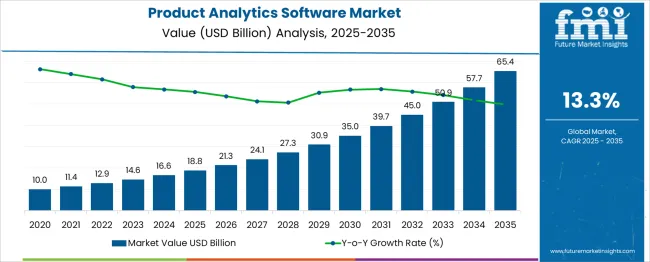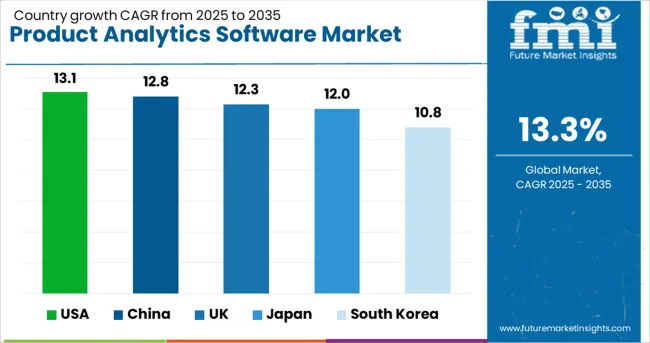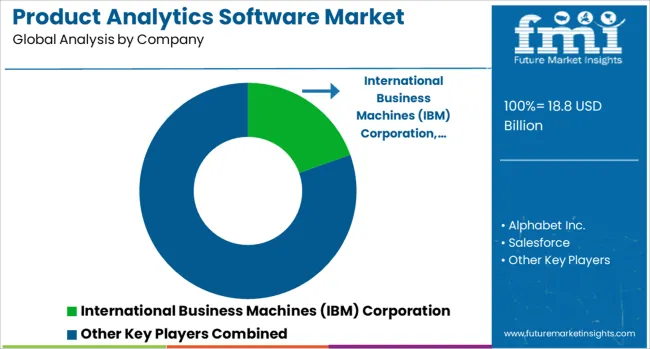The Product Analytics Software Market is estimated to be valued at USD 18.8 billion in 2025 and is projected to reach USD 65.4 billion by 2035, registering a compound annual growth rate (CAGR) of 13.3% over the forecast period.

| Metric | Value |
|---|---|
| Product Analytics Software Market Estimated Value in (2025 E) | USD 18.8 billion |
| Product Analytics Software Market Forecast Value in (2035 F) | USD 65.4 billion |
| Forecast CAGR (2025 to 2035) | 13.3% |
Rising Demand for Cloud-Based Analytical Solutions to Boost the Market in coming years
The rising penetration of big data technologies, cloud computing, and other advanced technologies has prompted product analytics software providers to transform services to a whole new level. As per market research FMI, the market for product analytics software witnessed a staggering 15.6% CAGR from 2020 to 2024.
As enterprises strive to attain a competitive edge, product analytics software is a necessity. Demand for cloud analytics is the next big thing coming in the product analytics market and extends the enormous opportunity for product analytics software. The advent of cloud computing has pushed the sells planning to a new level and is expected to have a long-term impact on the product analytics market.
The presence of Data Breaching and Malware Attacks due to Enhanced Technological Infrastructure is expected to be the key factor hampering the market growth in the forecast period.
Also, expenses associated with product analytics are likely to discourage the entrance of new players into the market, thereby, limiting the market growth. Moreover, the availability of low-cost alternative services is further speculated to hinder trade growth during the forecast period.
One more challenge faced by market players is the lack of skilled professionals understanding data analysis and inadequate capital which is projected to limit the growth through the forecast period.
As per the analysis, the deployment type sector is anticipated to hold remunerative opportunities for the global product analytics software market. The adoption of technologies like machine learning, and AI by product-specific industries like manufacturing is driving the demand for the product analytics software market.
As product analytics software provides critical information to optimize performance, diagnose problems, and correlate customer activity with long-term value, increases its demand in different industries such as Manufacturing, Automotive, Healthcare, Energy & Utility, Government, and Retail. For instance, in 2024 the Department of Health and Human Services (HHS), the Department of Veterans Affairs, and the Department of Energy (DOE) announced a new big data analytics initiative to coordinate and share COVID-19 information.
The increasing need for organizations for monitoring competitiveness is driving the product analytics software market globally. The increasing demand for cloud-based analytical solutions is fueling the demand of the industry. In addition, technological developments and favorable government plans create promising economic opportunities in the market.
Demand for Product Analytics Software to be Maximum by Offering
As per the analysis, by offerings, the software segment is likely to dominate the market in the forecast period. The software segment is anticipated to expand at a CAGR of 13.2% during the forecast period.
Growth can be attributed to the increasing demand for advanced analytics tools to ensure market competitiveness and the growing adoption of big data and other related technologies.
Will Cloud-based Product Analytics Software remain Preferred?
By deployment type, cloud-based product analytics software is projected to dominate the market during the forecast period. The segment is expected to grow at a 12.7% CAGR in the assessment period.
Many organizations nowadays deploy cloud-based solutions due to scalability, flexibility in capacity, enhanced collaboration, and cost-efficiency. The Cloud-based product analytics software offers a centralized way to integrate the system and its components with web and mobile applications and helps organizations boost their sales performance.
North America to be a Lucrative Market for Product Analytics Software
North America is anticipated to lead the global product analytics software market during the forecast period. The market is likely to garner USD 18.8 Billion while exhibiting a CAGR of 13.1% from 2025 to 2035. Product analytics software sales in the USA are projected to offer lucrative opportunities for revenue generation over the forecast period.
The dominance of North America is attributed to the increased demand for product analytics outsourcing from sectors including BFSI, retail, telecommunication, and healthcare.
Burgeoning technological advancements in the region are key factors favoring the growth of the product analytics market. The presence of leading players such as International Business Machines (IBM) and Oracle Corporation, to name a few will continue driving sales in the country. The increasing number of product analytics players across regions is expected to further drive market growth.
Asia Pacific to be another Opportunistic Geography for Investment
Asia Pacific is anticipated to be the fastest-growing region during the forecast period. China is likely to make the most significant contribution to developing the market. China is estimated at USD 3.4 Billion, expanding at a 12.8% CAGR during the forecast period. China is expected to be the leading market due to the growing introduction of advanced technologies in the region.
The growth of the market can be attributed to the presence of evolving countries such as; India, China, Japan, and others. Also, strategic initiatives by key market players and government initiatives undertaken in the country drive the growth of the market in forecasting years.
In addition, Japan has been recognized as another potent player in the region. According to the analysis, the country is anticipated at USD 2.8 Billion while recording a CAGR of 12.0% in the forecast period. The development of the regional market can be credited to the rapid development in the concerned field, while South Korea is expected to be estimated at USD 1.6 Billion.

| Countries | Estimated CAGR |
|---|---|
| USA | 13.1% |
| China | 12.8% |
| UK | 12.3% |
| Japan | 12.0% |
| South Korea | 10.8% |

Eminent players in the global product analytics software market include International Business Machines (IBM) Corporation, Alphabet Inc., Salesforce, Oracle Corporation, and SAP SE among others. Recent key developments among players include:
The global product analytics software market is estimated to be valued at USD 18.8 billion in 2025.
The market size for the product analytics software market is projected to reach USD 65.4 billion by 2035.
The product analytics software market is expected to grow at a 13.3% CAGR between 2025 and 2035.
The key product types in product analytics software market are software, service, _professional and _managed.
In terms of solution, web-based segment to command 63.5% share in the product analytics software market in 2025.






Full Research Suite comprises of:
Market outlook & trends analysis
Interviews & case studies
Strategic recommendations
Vendor profiles & capabilities analysis
5-year forecasts
8 regions and 60+ country-level data splits
Market segment data splits
12 months of continuous data updates
DELIVERED AS:
PDF EXCEL ONLINE
Product Life-Cycle Management (PLM) IT Market Size and Share Forecast Outlook 2025 to 2035
Products from Food Waste Industry Analysis in Korea Size, Share and Forecast Outlook 2025 to 2035
Products from Food Waste in Japan - Size, Share, and Forecast Outlook 2025 to 2035
Production Logistics Market Size and Share Forecast Outlook 2025 to 2035
Products from Food Waste Market Analysis - Size, Growth, and Forecast 2025 to 2035
Product Design Verification And Validation Solution Market Size and Share Forecast Outlook 2025 to 2035
Production Printer Market - Growth, Demand & Forecast 2025 to 2035
Product Information Management Market Growth – Trends & Forecast 2024-2034
Product Dispensing Machinery Market
Product Cost Management Market
CBD Product Packaging Market Size and Share Forecast Outlook 2025 to 2035
USA Products from Food Waste Market Growth – Trends, Demand & Outlook 2025-2035
Competitive Overview of CBD Product Packaging Market Share
Soda Production Machine Market Size and Share Forecast Outlook 2025 to 2035
Competitive Overview of Date Product Market Share
Teff Products Market
Dairy Product Packaging Market Size and Share Forecast Outlook 2025 to 2035
Glass Product Market Size and Share Forecast Outlook 2025 to 2035
Early Production Facility Market Size and Share Forecast Outlook 2025 to 2035
Detox Products Market Analysis - Size, Share, and Forecast Outlook 2025 to 2035

Thank you!
You will receive an email from our Business Development Manager. Please be sure to check your SPAM/JUNK folder too.
Chat With
MaRIA